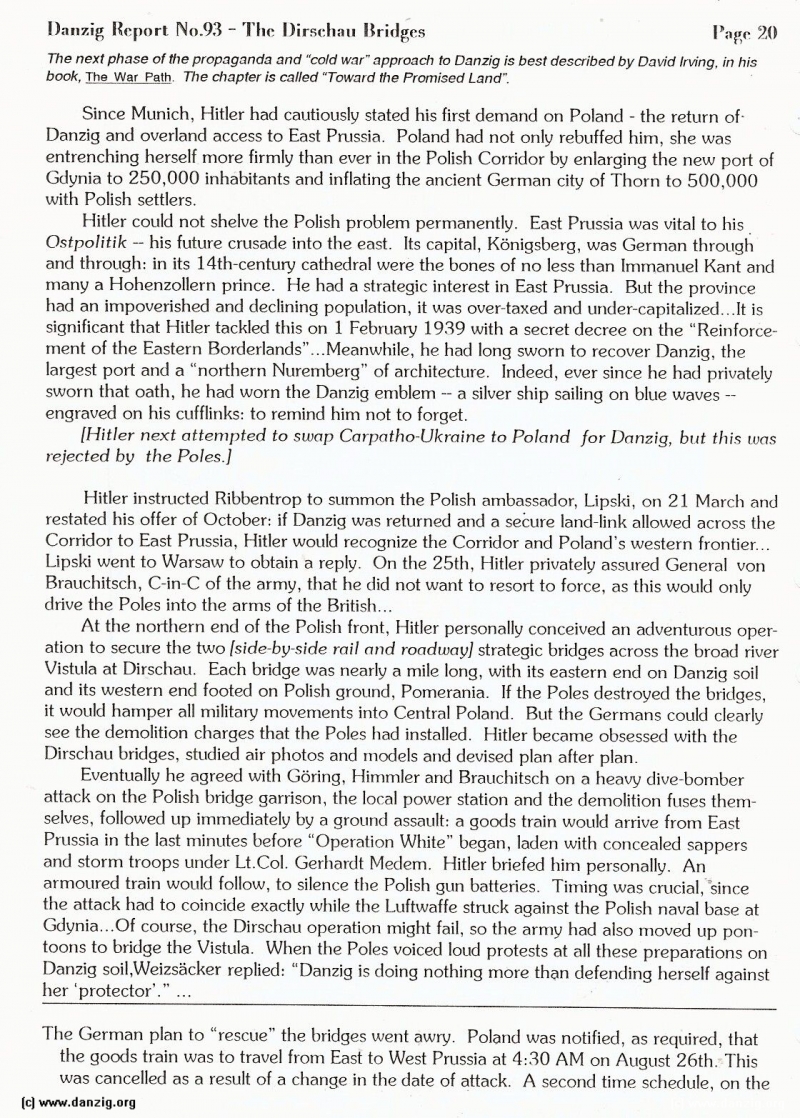
The next phase of the propaganda and “cold war” approach to Danzig is best described by David Irving, in his book, The War Path The chapter is called “Toward the Promised Land
Since Munich, Hitler had cautiously stated his first demand on Poland - the return of- Danzig and overland access to East Prussia. Poland had not only rebuffed him, she was entrenching herself more firmly than ever in the Polish Corridor by enlarging the new port of Gdynia to 250,000 inhabitants and inflating the ancient German city of Thorn to 500,000 with Polish settlers.
Hitler could not shelve the Polish problem permanently. East Prussia was vital to his Ostpolitik -- his future crusade into the east. Its capital, Konigsberg, was German through and through: in its 14th-century cathedral were the bones of no less than Immanuel Kant and many a Hohenzollern prince. He had a strategic interest in East Prussia. But the province had an impoverished and declining population, it was over-taxed and under-capitalized.. .It is significant that Hitler tackled this on 1 February 1939 with a secret decree on the “Reinforcem ent of the Eastern Borderlands”.. .Meanwhile, he had long sworn to recover Danzig, the largest port and a “northern Nuremberg” of architecture. Indeed, ever since he had privately sworn that oath, he had worn the Danzig emblem -- a silver ship sailing on blue waves -- engraved on his cufflinks: to remind him not to forget.
[Hitler next attempted to swap Carpat ho-Ukraine to Poland for Danzig, but this was rejected by the Poles.]
Hitler instructed Ribbentrop to summon the Polish ambassador, Lipski, on 21 March arid restated his offer of October: if Danzig was returned and a seèure land-link allowed across the Corridor to East Prussia, Hitler would recognize the Corridor and Poland’s western frontier... Lipski went to Warsaw to obtain a reply. On the 25th, Hitler privately assured General von Brauchitsch, C-in-C of the army, that he did not want to resort to force, as this would only drive the Poles into the arms of the British...
At the northern end of the Polish front, Hitler personally conceived an adventurous opera tion to secure the two Iside-by-side rail and roadu,ayj strategic bridges across the broad river Vistula at Dirschau. Each bridge was nearly a mile long, with its eastern end on Danzig soil and its western end footed on Polish ground, Pomerania. If the Poles destroyed the bridges, it would hamper all military movements into Central Poland. But the Germans couki clearly see the demolition charges that the Poles had installed. Hitler became obsessed with the Dirschau bridges, studied air photos and models and devised plan after plan.
Eventually he agreed with Goring, Himmier and Brauchitsch on a heavy dive-bomber attack on the Polish bridge garrison, the local power station and the demolition fuses thems elves, followed up immediately by a ground assault: a goods train would arrive from East Prussia in the last minutes before “Operation White” began, laden with concealed sappers and storm troops under Lt.Col. Gerhardt Medem. Hitler briefed him personally. An armoured train would follow, to silence the Polish gun batteries. Timing was crucial, since the attack had to coincide exactly while the Luftwaffe struck against the Polish naval base at Gdynia. . .Of course, the Dirschau operation might fail, so the army had also moved up pont ooris to bridge the Vistula. When the Poles voiced loud protests at all these preparations on Danzig soil,Weizsäcker replied: “Danzig is (loing nothing more than defending herself against her ‘protector’.”
The German plan to “rescue” the bridges went awry. Poland was notified, as required, that the goods train was to travel from East to West Prussia at 4:30 AM on August 26th. This was cancelled as a result of a change in the date of attack. A second time schedule, on the
Danzig Report Vol. 1 - Nr. 93 - October - November - December - 1996, Page 20.
Hits: 3302
Added: 19/07/2015
Copyright: 2025 Danzig.org

